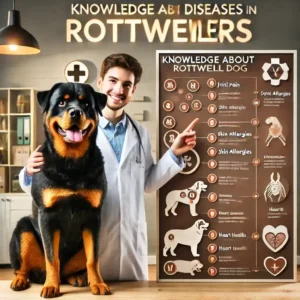Rottweiler Health Issues and How to Address Them
Rottweilers are strong and loyal dogs, but like all dog breeds, they can face certain health problems, including bone cancer. Knowing about Rottweiler Health Issues can help you care for your furry friend better. In this article, we’ll look at common health problems in Rottweilers and what you can do to keep your loyal Rottweiler dog healthy.
Key Takeaways
- Hip dysplasia is common in Rottweilers and can be managed with weight control, medication, and sometimes surgery.
- Aortic stenosis is a heart condition that can be managed with medication and regular vet checkups.
- Elbow dysplasia can cause pain and lameness, but can be treated with surgery or physical therapy.
- Obesity in Rottweilers can lead to other health problems; a balanced diet and regular exercise are crucial.
- Early cancer detection can improve treatment outcomes; regular vet visits are important.
Recognizing and Managing Hip Dysplasia in Rottweilers
Symptoms of Hip Dysplasia
Hip dysplasia is a painful condition where the hip joint doesn’t develop properly. Common signs include:
- Chronic or occasional lameness
- Limping without any previous injury
- A “bunny hopping” gait
- Difficulty rising, running, or jumping
Treatment Options for Hip Dysplasia
There are various treatments available depending on the severity of the condition:
- Medication: Pain relievers and anti-inflammatory drugs can help manage symptoms.
- Weight Control: Keeping your Rottweiler at a healthy weight reduces stress on the joints.
- Physical Therapy: Exercises to strengthen the muscles around the hip joint.
- Surgery: In severe cases, surgical options like hip replacement may be necessary.
Preventive Measures for Hip Dysplasia
Preventing hip dysplasia involves a combination of genetic and lifestyle choices:
- Healthy Weight Management: Ensure your dog maintains a healthy weight through a balanced diet and regular exercise.
- Regular Exercise: Avoid high-impact activities, especially during puppyhood.
- Orthopedic Screening: Early screening can help in planning appropriate care and management.
Early detection and proper management can significantly improve the quality of life for a Rottweiler with hip dysplasia.
Understanding Aortic Stenosis in Rottweilers and How to Address them

Causes of Aortic Stenosis
Aortic stenosis is a hereditary cardiac condition where the aortic valve is abnormally narrow. This makes the heart work harder to pump blood through the body. Since this condition is congenital, dogs are born with it, and it is often passed down from their parents.
Symptoms to Watch For
The most common sign of aortic stenosis is a heart murmur. However, some dogs may not show symptoms until they are older. Severe cases can lead to fainting, difficulty with exertion, and coughing. Regular checkups are essential to catch these signs early.
Treatment and Management
If your dog is diagnosed with aortic stenosis, your veterinarian will develop a treatment plan that may include medication, surgery, and/or lifestyle changes, especially considering that Rottweilers are prone to certain health concerns. Medication can help improve heart function, and with mild activity adjustments, many Rottweilers can live long and healthy lives.
Early detection and regular veterinary checkups are crucial for managing aortic stenosis effectively.
Issues with Rottweiler Breeding: An All-Inclusive Health Guide
Are you a Rottweiler fan or breeder? Large breeders need to understand the potential problems of breeding these amazing species. In this post, we will look at common health issues, genetic problems, and breeding complications that can arise when breeding Rottweilers.
Rottweiler Health Issues & Concerns
- Hip dysplasia: An inborn disorder causing joint pain and difficulties in joint development.
- Elbow Dysplasia: Induces suffering and compromises elbow joint performance.
- Allergies: Nourishment and skin sensitivities call for prudent care and attention.
- Cancer: Pole cell tumors, lymphomas, and osteosarcoma are common.
Twinning Elbow Dysplasia in Rottweilers

Signs and Indications of Elbow Dysplasia
Elbow dysplasia is a condition where the elbow joint doesn’t create legitimately. This can cause torment, firmness, and weakness, particularly amid the action. Observe for signs like swelling, limping, and an abnormal gait. On the off chance that your Rottweiler appears any of these indications, it’s vital to”> allude to your vet.
Treatment Choices
There are a few ways to treat elbow dysplasia, which is a common issue in Rottweilers and other dog breeds. Gentle cases may be overseen by a pharmacist and physical therapist. In any case, surgery is usually the best choice for elbow dysplasia treatment, especially in Rottweilers who are prone to certain health issues. Untreated dysplasia can contrarily influence your Rottweiler’s quality of life. Your veterinarian will assist you in choosing the best course of action based on the seriousness of the condition.
Preventive Procedures
Avoiding elbow dysplasia includes many key steps:
- Solid Weight Management: Keeping your Rottweiler at a solid weight diminishes the push on their joints and helps avoid health concerns such as bone cancer, which many Rottweilers face.
- Normal Work: Lock into low-impact exercises like strolling and swimming to keep their joints sound.
- Orthopedic Screening: Early screening can offer assistance to distinguish issues that have sometimes recently gotten to an extreme. Typically particularly vital if you plan to breed your Rottweiler, as they are prone to certain health concerns.
Common Cardiovascular Rottweiler Health Issues in Rottweilers
Rottweilers are prone to a few cardiovascular issues, which can altogether affect their well-being and life expectancy, making pet insurance a wise consideration. Regular veterinary checkups are vital for the early location and administration of these conditions.
Avoiding and Overseeing Corpulence in Rottweilers
Dangers Related to Weight
Weight in Rottweilers can lead to genuine well-being issues, including joint issues, heart disease, and diabetes, which loyal Rottweilers aren’t immune to. Keeping your Rottweiler at a sound weight is crucial to avoid these complications, as they are prone to certain health issues. Overweight mutts are more likely to endure joint pain and other mobility issues, which can altogether decrease their quality of life.
Dietary Suggestions
To oversee your Rottweiler’s weight, it’s critical to nourish them with an adjusted slim-down. Consult your veterinarian to determine lead nourishment and parcel sizes for your dog. Dodge gives table scraps and constrained treats. Instep, select solid snacks like carrots or apple slices.
Working out the Rules
A standard workout is fundamental for anticipating corpulence. Lock in your Rottweiler for daily physical exercise such as strolls, recess, and low-impact work like swimming. Point for at slightest 30 minutes of workout each day to assist them burn off an abundance of calories and keep up a solid weight
Losing an abundance of weight requires a sound count of calories combined with day-by-day physical action. Supplements such as probiotics and CBD oil offer assistance to oversee canine corpulence.
By following these rules, you’ll be able to offer assistance to guarantee your Rottweiler remains fit and solid, as Rottweilers need proper care.
Cancer Dangers in Rottweilers
Sorts of Cancer Common in Rottweilers
Rottweilers are more inclined to certain sorts of cancers, including osteosarcoma, lymphoma, and hemangiosarcoma, which many Rottweilers may face. Considers recommend fixing or spending 1 year before age to extend the hazard of osteosarcoma in both male and female Rottweilers, as they are prone to certain health issues. The value of timing is emphasized in these approaches.
Early Discovery and Side Effects
Early diagnosis is important for effective treatment. Be aware of common side effects.
- Knots or bumps on the body
- Unexplained weight loss
- Changes in cravings
- Dormancy or diminished vitality
Regular veterinary checkups can help identify these signs early. Check your dog regularly and ensure regular checkups to rule out tumours.
Treatment Choices and Forecast
Cancer treatment options depend on the type and spread of the cancer. Treatments, including surgery, chemotherapy, and radiation treatment, can be used.
While cancer may be an honest-to-goodness assurance, it isn’t persistently a passing sentence. Various pooches, including Rottweiler puppies, respond well to treatment and can live cheerful, sound lives post-diagnosis.
Early location, normal veterinary care, and a sound lifestyle can boost the potential for effective treatment and longer survival, especially for Rottweilers who are prone to certain health problems.
Managing Sensitivities in Rottweilers
Common Allergens
Rottweilers can be unfavorably susceptible to different things, including dust, cleaning products, and certain shampoos. A thick undercoat gathers microbes and insects, leading to skin responses. It’s necessary to identify the allergen to provide effective treatment.
Indications of Sensitivities
Hypersensitivities in Rottweilers commonly reveal themselves through aggravated skin conditions, rashes, and recurring ear infections. You might take note of your canine licking their paws, rubbing their go up against, or making small rosy bumps in their undercoat. These side effects commonly start between the ages of one and three and can decrease over time.
Treatment and Administration
There are several treatment options open for directing hypersensitivities in Rottweilers, which can help mitigate health concerns that many Rottweilers face. Antihistamine medications can piece touchiness signs. Examples of antihistamines utilized to treat normal pooch hypersensitivities include clemastine and trimeprazine. Standard vet visits are imperative for keeping your Rottweiler sound and supervising their sensitivities reasonably.
Conclusion
Rottweilers are loved for their optimism and warmth, but they can also share some health benefits. Depending on the location of health problems such as gastric dysplasia, heart disease, and muscle weakness, you should take steps to protect your Rottweiler’s health. Remember, many of these problems; early placement and proper care can make a huge difference in your dog’s quality of life. With will and love, your Rottweiler will enjoy long, happy sounds by your side.
Frequently Asked Questions
Signs of hip dysplasia in Rottweilers consolidate limping, inconvenience standing up, hesitance to run or bounce, and recognizable torment inside the hip zone.
Aortic stenosis can be an acquired characteristic, making it fundamental to select a legitimate breeder who conducts hereditary testing on their mutts. Early wellbeing issues can be accomplished through customary veterinary checkups.
Your Rottweiler limping or elbow torment warrants a visit to the vet for an appropriate conclusion and proposed treatment, which might include pharmaceuticals or surgery.
To determine the weight of your Rottweiler, keep a balanced diet, minimize threats, and ensure regular exercise.
Cancer types like osteosarcoma, lymphoma, and hemangiosarcoma are common in Rottweilers. Veterinary appointments can aid in early diagnosis.
Treatment for sensitivities in Rottweilers incorporates recognizing and maintaining a strategic distance from allergens, utilizing medicines endorsed by your vet, and some of the time dietary changes.











